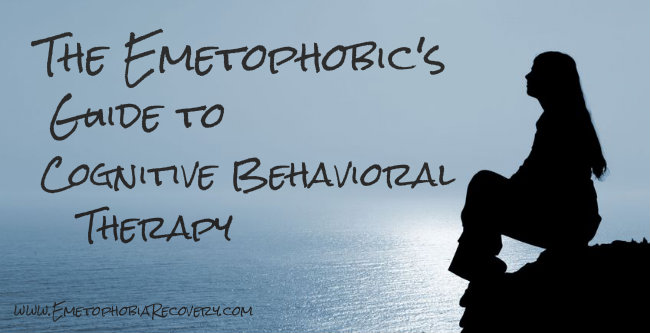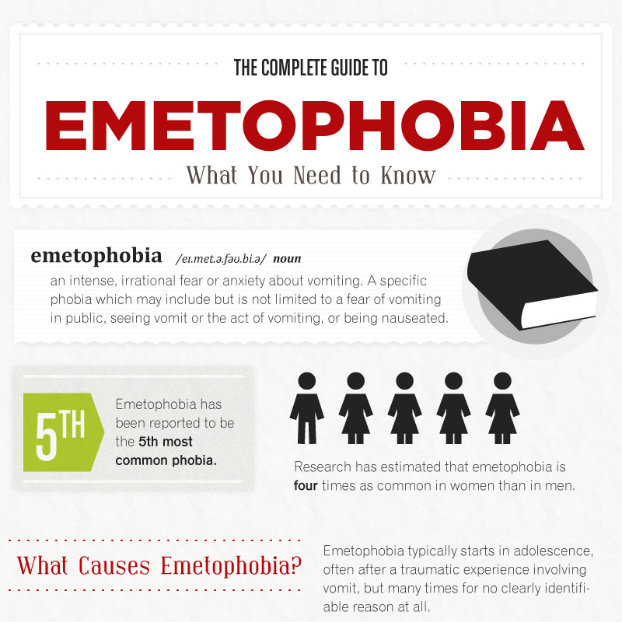 You think, therefore you are. French philosopher Rene Descartes told you that. You may also be aware of a variation on his quote that says if you think negatively, you therefore are miserable, full of fear, wrapped in anxiety, suffering from emetophobia and prone to negative behaviors that can seem to ruin your life.
You think, therefore you are. French philosopher Rene Descartes told you that. You may also be aware of a variation on his quote that says if you think negatively, you therefore are miserable, full of fear, wrapped in anxiety, suffering from emetophobia and prone to negative behaviors that can seem to ruin your life.
Here’s where cognitive behavioral therapy (CBT) may be able to help if you feel that your situation is better suited to one on one individual treatment than the program we offer here that you can use in your own home on your own. Despite its fancy-sounding name, CBT is simply a type of psychotherapy that focuses on your thoughts and how they control your emotions and actions. It then aims to readjust the way you think to alleviate negative emotions and actions that have no bearing in reality.
CBT has been very helpful for treating emetophobia and other fears, can be effective in as few as four to seven months, and can transform not only your thinking but your entire way of life.
What It Is
Your thinking encompasses your random thoughts, non-random thoughts, your beliefs, your attitudes and images you harbor in your brain. The way you think and the content of those thoughts play a huge role in how you feel and how you act.
You phobia and other negative emotions can then lead to negative or irrational behaviors, such as hiding from people and situations or even engaging in self-destruction. The goal of CBT is to change your thinking in order to change your actions and behaviors.
“CBT is based on a model or theory that it’s not events themselves that upset us, but the meanings we give them,” PsychCentral says. “If our thoughts are too negative, it can block us seeing things or doing things that don’t fit – that disconfirm – what we believe is true. In other words, we continue to hold on to the same old thoughts and fail to learn anything new.”
Unlike traditional psychodynamic psychotherapy where you lie on a couch and spew your issues surrounding your emetophobia at the therapist, CBT instead combines forces. You and your therapist work as a team to tackle your fears about vomiting.
“People who seek CBT can expect their therapist to be problem-focused, and goal-directed in addressing the challenging symptoms of mental illnesses,” explains the National Alliance on Mental Health, or NAMI. “Because CBT is an active intervention, one can also expect to do homework or practice outside of sessions.”
Yes, you may even get homework.
History
 The origins of cognitive behavioral therapy date back to the 1960s, when a psychiatrist named Aaron T. Beck noticed his patients would frequently have internal dialogues with themselves. A patient who might be sitting in silence for all appearances sake would often have a whole conversation going on in his head.
The origins of cognitive behavioral therapy date back to the 1960s, when a psychiatrist named Aaron T. Beck noticed his patients would frequently have internal dialogues with themselves. A patient who might be sitting in silence for all appearances sake would often have a whole conversation going on in his head.
Perhaps the patient starts to think things like, “Why isn’t the therapist talking? Is he mad at me? Did I do something wrong? I must have done something wrong.” Once those thoughts kick in, the patient can instantly become antsy, worried or even annoyed and angry.
The thoughts may continue, with the patient reviewing his actions over the last few sessions and realizing he didn’t do anything that should have made the therapist irked at him. “Whew, it must not be me,” the guy’s thoughts continue. “Maybe the therapist is just tired or has a stomach ache or maybe had a fight with his wife.”
While you may have heard that thoughts are not facts, Beck still noted the big fact that thoughts played a part in the patient’s emotions. Beck may have watched his patient go from antsy to calm for no apparent reason but pinpointed the reason back to the thoughts bouncing around the patient’s head.
Beck coined the term “automatic thoughts” to describe the phenomenon of such emotion-filled thoughts, and he also found that people weren’t always conscious that these thoughts were invading their minds. Although folks didn’t always realize the thoughts were present, with help they could learn to notice when the thoughts popped up and then discuss them with the therapist.
Perhaps not surprisingly, Beck found that when patients were worried or upset, most of the “automatic thoughts” that popped up in their heads tended to be negative and only serve to make matters worse.
“Beck found that identifying these thoughts was the key to the client understanding and overcoming his or her difficulties,” PsychCentral says.
Cognitive therapy was the term Beck originally used because the therapeutic method relied on cognition, or thinking. The term was expanded into cognitive behavioral therapy as the therapeutic method involved thinking as well as behavioral techniques.
Various types of CBT exist, but they all fall under the umbrella term if they involve the way you think in relation to the way you act.
How CBT Works
CBT can work rather quickly, but it does take courage, strength and effort on your part. It also takes plenty of persistence. You have to remember that all your negative thoughts, beliefs, attitudes and images were most likely stored up over an extended period of time. That means it may take some deep digging and heavy sweeping to get them out of there.
The first phase of CBT is typically becoming aware of your negative thinking when it happens. After all, you can’t very well change something you don’t know exists. Being acutely aware of when, why and how those negative thoughts pop into your head gives you a solid foundation on which to build the rest of your program.
While CBT can help with a vast scope of issues, ranging from insomnia to schizophrenia, you want to take one issue at a time so you remain focused and able to give it your full attention. So an initial focus on overcoming emetophobia would be a great place to start.
Each therapist may have a slightly different approach to CBT, but MayoClinic.com provides a general rundown of the steps typically involved:
- Identifying your issues, problems and where your treatment should focus (i.e. emetophobia)
- Becoming aware of your beliefs, thoughts and emotions surrounding your emetophobia
- Pinpointing your inaccurate or negative thinking
- Challenging that inaccurate or negative thinking
It’s already established that emetophobia is front and center on your problem list of issues you want to tackle. You may understand full well that your fear of vomiting has a more control over your life than it should. Perhaps it prevents you from attending social functions and sends you into panic attacks when flu season hits. Your therapist can help you dig into other negative impacts your phobia has on your life.
Part of understanding the problem may be to understand its origins. When and how did this fear develop? What are the triggers? What is the basis for these fears? What evidence do you use to support them?
Your emetophobia may give you the beliefs that “vomiting is bad” or even “vomiting will kill me!” Although you might view such beliefs as ultimate truths, your therapist can help you explore and then challenge those beliefs in order to see they are not true at all.
Challenging Beliefs
 Your therapist may recommend a number of exercises to try at home, in her office, or both. You want to make sure you proceed at a pace that feels comfortable, although you can pretty much bet exploring the thoughts is going to give you a bit of discomfort. Your efforts, however, may be well worth it as CBT can help you potentially kick out the anxiety and emetophobia for the rest of your life.
Your therapist may recommend a number of exercises to try at home, in her office, or both. You want to make sure you proceed at a pace that feels comfortable, although you can pretty much bet exploring the thoughts is going to give you a bit of discomfort. Your efforts, however, may be well worth it as CBT can help you potentially kick out the anxiety and emetophobia for the rest of your life.
That said, NAMI mentions several methods your therapist may use to help you change your thought process:
- Running experiments – Rather than taking your vomit fears as the end-all truth, your therapist may suggest a series of running experiments to test these so-called truths. For instance, if your so-called truth tells you that you’re going to get sick if you eat food you didn’t prepare yourself, a running experiment may be to partake of some food someone else cooked to challenge the belief.
- Exploring old evidence – Exploring the evidence that led to your so-called truths is another useful tool. Perhaps you missed an important point while putting together your old evidence or otherwise overlooked factors that don’t support your belief. Let’s say your truth that you’ll get sick from food you didn’t prepare yourself stems from a long-ago incident where you got sick after eating peanut brittle your neighbor made. Maybe you find out you are, in fact, allergic to peanuts and the truth is not that your neighbor preparing the food made you ill, but the fact that the food contained peanuts.
- Exposure treatment – This type of treatment is often helpful for any type of phobia, and it may help give your emetophobia a big kick to the curb. Here you are exposed to what you fear in a safe and controlled environment. Exposure starts at very low levels, such as photos or cartoon drawings, and works up to higher levels as you learn to change your beliefs surrounding your vomit fears.
- Automatic thought journal – Keeping a thought journal is definitely a good homework assignment. Here you write down all the automatic thoughts that pop up in your head throughout the day. You and your therapist can then review the thoughts to identify patterns of thinking that lead to negative thoughts and subsequent negative behaviors.
- Establishing goals – Creating a list of goals that may at first seem impossible, like eating out at a restaurant, but then become attainable is another useful technique. Conquering the goals could fall into the running experiment category that continues to test old beliefs to illustrate their veracity or lack thereof.
What to Expect
Don’t worry, you’re not going to walk into a therapist’s office and suddenly be exposed to what you fear most. As noted, you’re going to move at your own pace in a safe and controlled environment. Besides, your first session will be about gathering information and letting the therapist learn more about your fears before the treatment can effectively begin.
It may take more than one session to gather all the info, which will include your medical and mental health history, but you should get a good idea on the first visit if you feel comfortable working with this particular therapist. Early visits also give you a chance to learn more about the therapist’s approach, the type of therapy and techniques he may use and the overall goals of your treatment. CBT is usually done on a one-on-one basis, but it is possible to use it with groups who share the same issues.
While your overall treatment plan can be as brief as 20 sessions or so, the exact length of time it will take to sift through all the issues depends on many factors. These include your issues’ complexity, severity, how long you’ve been suffering, any additional stress you’ve been experiencing and how much support you receive from family and friends. CBT sessions typically meet once a week, with each session lasting about 50 minutes. Don’t forget to do your homework!
How to Find a CBT Therapist
 You have several ways to start your search for a CBT therapist, keeping in mind you want to work with someone with whom you feel comfortable and safe. Some personalities don’t click, and that’s certainly OK. Your best results will come from working with someone compatible.
You have several ways to start your search for a CBT therapist, keeping in mind you want to work with someone with whom you feel comfortable and safe. Some personalities don’t click, and that’s certainly OK. Your best results will come from working with someone compatible.
Referrals: Referrals from family members, friends you know in therapy, your primary care physician or other trusted sources can work for helping you find a CBT therapist. Even if the therapist to which people refer you does not typically work with emetophobics or doesn’t offer CBT, he or she may be able to direct you to someone who does. Your insurance plan may have a list of available CBT therapists in your area. Also check if your employer offers counseling or referrals through an employee assistance program, or EAP.
Searching on your own: The phone book and Internet generally have loads of therapists listed. Online you can often search for specialties, specific locations, types of therapies used and ratings or reviews.
Do your homework: To ensure you’re getting a quality therapist, start your homework before you even start your sessions. Check out your chosen therapist’s credentials, prior experience with CBT, educational background and any required licensing. You also want to check what type of mental health coverage your insurance plan has, as they all differ widely. Some may limit the total amount of visits or the frequency of visits, facts you want to know before you begin. Even if your insurance plan is limited, therapists may be open to working out an affordable way for you to receive the help you want and need, so don’t be afraid to ask.
Honesty, openness and courage are all going to be part of your CBT therapy, so you may as well kick them into gear from the get-go.
Alternatives to CBT
If you feel you would do well working on your own, prefer the privacy of an at-home solution, or can’t find a therapist in your area who specializes in treating emetophobia, you can always consider a program such as the one we provide or a similar one you think would be right for your life and preferences. Many resources are based on the principles of cognitive behavioral therapy and can allow you to derive the majority of the benefits in a more convenient and cost-effective way.
SOURCES:
Photo Credit: Thibodeau Photography, Erin Rena, Brian Scott Berkovitz Photography





